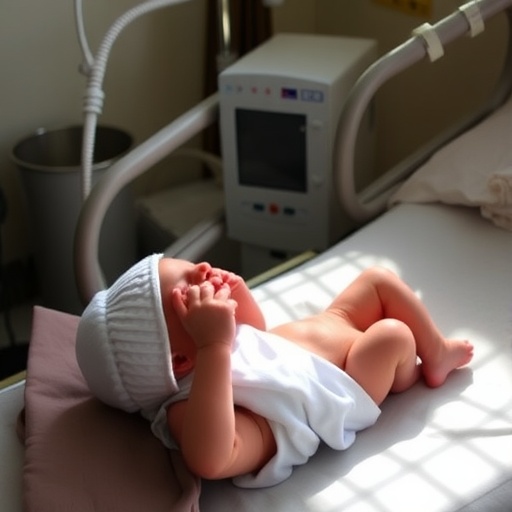In a groundbreaking development in neonatal care, researchers have revisited an age-old therapy with a modern twist: filtered-sunlight phototherapy for neonatal hyperbilirubinemia. This innovative approach, detailed in a recent publication by Olusanya, Emokpae, and Mabogunje in Pediatric Research, underscores the critical importance of contextual factors in implementing sunlight-based treatments for newborn jaundice effectively.
Neonatal hyperbilirubinemia, commonly known as newborn jaundice, affects a significant proportion of infants worldwide. It results from an excess of bilirubin in the blood, a byproduct of red blood cell breakdown. While mild jaundice is typically harmless and resolves naturally, severe cases can lead to kernicterus, a deadly type of brain damage. Phototherapy has long been the treatment cornerstone, utilizing artificial blue light to break down bilirubin in the skin. However, the accessibility and affordability of conventional phototherapy units remain a challenge, especially in low-resource settings.
The study spearheaded by these researchers advocates harnessing filtered sunlight as a viable alternative to conventional therapy, particularly in regions where access to electric phototherapy units is limited or inconsistent. The principle relies on the photodegradation of bilirubin using sunlight filtered to exclude harmful ultraviolet (UV) and excessive infrared (IR) radiation. This precautionary filtering ensures that while the therapeutic blue spectrum is allowed through, the neonate remains protected from potential skin burns and heat exposure.
From a technical standpoint, the filtered-sunlight phototherapy system incorporates advanced optical filtering materials designed to selectively transmit blue wavelengths around 460-490 nanometers—the absorption peak of bilirubin molecules. These materials also drastically reduce UV exposure, which can cause acute skin damage, and minimize IR wavelengths to reduce thermal risk. The result is an optimized therapeutic window leveraging natural solar irradiance while preserving neonatal safety.
However, as the researchers emphasize, the success and safety of this intervention are not solely dependent on the optical properties of the filter. Ambient environmental factors—altitude, latitude, weather conditions, and time of day—profoundly affect the intensity and spectral composition of sunlight. Hence, what works well in one region may not translate directly to another. Accurate contextual assessments and localized guidelines are imperative for the effective implementation of filtered-sunlight phototherapy.
Intriguingly, the authors documented that neonatal response to filtered sunlight closely mirrored outcomes observed with conventional phototherapy units under controlled conditions. They observed significant reductions in serum bilirubin levels within 24 to 48 hours of therapy initiation without adverse effects related to overexposure. Importantly, the intervention also demonstrated cost-effectiveness and sustainability, critical factors for newborn care in underprivileged communities with scarce medical infrastructure.
To ensure safety, the researchers propose extensive training modules for healthcare providers on correctly administering filtered-sunlight therapy. This includes protocols on exposure duration, monitoring of bilirubin levels, and vigilant observation of neonatal skin condition. Additionally, they recommend designing sheltering structures that maximize sunlight exposure while protecting infants from direct UV rays and inclement weather, addressing practical implementation challenges.
The report delves deeper into the photochemical mechanism underpinning this pioneering method. Bilirubin’s photosensitivity arises from its conjugated double-bond system, enabling it to absorb light and undergo isomerization and structural breakdown. This photodegradation transforms bilirubin into water-soluble isomers easily excreted without requiring hepatic conjugation, a crucial aspect for immature neonatal livers.
Despite its promise, the approach is not devoid of limitations. Variability in sunlight exposure demands constant monitoring and possibly real-time adjustments to treatment protocols. Additionally, the risk of dehydration or hypothermia in neonates exposed to external environments for therapy mandates careful environmental control. Nevertheless, these manageable concerns are far outweighed by the intervention’s accessibility and low operational cost.
The researchers envision that filtered-sunlight phototherapy could revolutionize neonatal jaundice management, especially within resource-poor hospitals and community health settings lacking reliable electricity. Implementation on a large scale could dramatically reduce neonatal morbidity and mortality related to severe hyperbilirubinemia, aligning with global health equity goals.
Future research directions highlighted include the integration of automated filtering systems paired with solar tracking technology, which could dynamically adjust filtering parameters to optimize therapeutic efficacy throughout the daylight hours. Moreover, there is scope for developing portable, easy-to-use filtered-sunlight phototherapy units for home-based neonatal care under professional guidance.
This study’s implications resonate beyond neonatal care, hinting at broader applications of spectrally filtered natural light therapies for various photodermatoses and other light-responsive conditions. By marrying cutting-edge optical engineering with an intuitive understanding of local environment and patient context, this approach charts a new frontier in photomedicine.
In conclusion, the work by Olusanya, Emokpae, and Mabogunje reinvigorates interest in sustainable, context-aware therapeutic modalities deeply rooted in nature’s inherent resources. Their evidence-based analysis confirms that while filtered-sunlight phototherapy is not a blanket solution, its contextual implementation represents a potent weapon in the global battle against neonatal jaundice’s devastating effects. This marriage of tradition, technology, and contextual sensitivity promises to illuminate a path toward safer, more accessible neonatal healthcare worldwide.
Subject of Research: Filtered-sunlight phototherapy as a treatment for neonatal hyperbilirubinemia
Article Title: Filtered-sunlight phototherapy for neonatal hyperbilirubinemia: context matters
Article References:
Olusanya, B.O., Emokpae, A.A. & Mabogunje, C.A. Filtered-sunlight phototherapy for neonatal hyperbilirubinemia: context matters. Pediatr Res (2025). https://doi.org/10.1038/s41390-025-04663-0
Image Credits: AI Generated
DOI: https://doi.org/10.1038/s41390-025-04663-0
Tags: accessible medical treatments for infantsbilirubin photodegradationcontextual factors in phototherapy implementationconventional phototherapy alternativesfiltered sunlight phototherapyinnovative neonatal care solutionskernicterus prevention strategieslow-resource healthcare strategiesneonatal hyperbilirubinemia managementneonatal jaundice treatmentnewborn jaundice research insightssun-based therapies for infants





